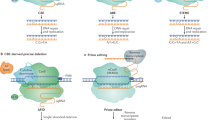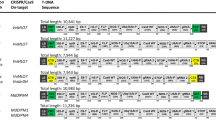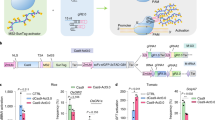Abstract
The CRISPR–Cas9 genome-editing tool and the availability of whole-genome sequences from plant species have revolutionized our ability to introduce targeted mutations into important crop plants, both to explore genetic changes and to introduce new functionalities. Here, we describe protocols adapting the CRISPR–Cas9 system to apple and grapevine plants, using both plasmid-mediated genome editing and the direct delivery of CRISPR–Cas9 ribonucleoproteins (RNPs) to achieve efficient DNA-free targeted mutations in apple and grapevine protoplasts. We provide a stepwise protocol for the design and transfer of CRISPR–Cas9 components to apple and grapevine protoplasts, followed by verification of highly efficient targeted mutagenesis, and regeneration of plants following the plasmid-mediated delivery of components. Our plasmid-mediated procedure and the direct delivery of CRISPR–Cas9 RNPs can both be utilized to modulate traits of interest with high accuracy and efficiency in apple and grapevine, and could be extended to other crop species. The complete protocol employing the direct delivery of CRISPR–Cas9 RNPs takes as little as 2–3 weeks, whereas the plasmid-mediated procedure takes >3 months to regenerate plants and study the mutations.
This is a preview of subscription content, access via your institution
Access options
Access Nature and 54 other Nature Portfolio journals
Get Nature+, our best-value online-access subscription
$29.99 / 30 days
cancel any time
Subscribe to this journal
Receive 12 print issues and online access
$259.00 per year
only $21.58 per issue
Buy this article
- Purchase on Springer Link
- Instant access to full article PDF
Prices may be subject to local taxes which are calculated during checkout




Similar content being viewed by others
References
Osakabe, Y., Osakabe, K., Shinozaki, K. & Tran, L. S. P. Response of plants to water stress. Front. Plant Sci. 5, 86 (2014).
Kanchiswamy, C. N. et al. Looking forward to genetically edited fruit crops. Trends Biotechnol. 33, 62–64 (2015).
Osakabe, Y. et al. Optimization of CRISPR–Cas9 genome editing to modify abiotic stress responses in plants. Sci. Rep. 6, 26685 (2016).
Song, G. et al. CRISPR/Cas9: a powerful tool for crop genome editing. Crop J. 4, 75–82 (2016).
Zhang, Y. et al. Efficient and transgene-free genome editing in wheat through transient expression of CRISPR/Cas9 DNA or RNA. Nat. Commun. 7, 12617 (2016).
Woo, J. W. et al. DNA-free genome editing in plants with preassembled CRISPR–Cas9 ribonucleoproteins. Nat. Biotechnol. 33, 1162–1164 (2015).
Jia, H. & Wang, N. Targeted genome editing of sweet orange using Cas9/sgRNA. PLoS ONE 9, e93806 (2014).
Fan, D. et al. Efficient CRISPR–Cas9-mediated targeted mutagenesis in Populus in the first generation. Sci. Rep. 5, 12217 (2015).
Nishitani, C. et al. Efficient genome editing in apple using a CRISPR–Cas9 system. Sci. Rep. 6, 31481 (2016).
Ren, C. et al. CRISPR–Cas9-mediated efficient targeted mutagenesis in Chardonnay (Vitis vinifera L.). Sci. Rep. 6, 32289 (2016).
Malnoy, M. et al. DNA-free genetically edited grapevine and apple protoplast using CRISPR–Cas9 ribonucleoproteins. Front. Plant Sci. 7, 1904 (2016).
GóMez-Lim, M. A. & Litz, R. E. Genetic transformation of perennial tropical fruits. In Vitro Cell. Dev. Biol. Plant 40, 442–449 (2004).
Gambino, G. & Gribaudo, I. Genetic transformation of fruit trees: current status and remaining challenges. Transgenic Res. 21, 1163–1181 (2012).
Kim, H. CRISPR/Cpf1-mediated DNA-free plant genome editing. Nat. Commun. 8, 14406 (2017).
Liang, Z. et al. Efficient DNA-free genome editing of bread wheat using CRISPR–Cas9 ribonucleoprotein complexes. Nat. Commun. 8, 14261 (2017).
Svitashev, S., Schwartz, C., Lenderts, B., Young, J. K. & Cigan, A. M. Genome editing in maize directed by CRISPR–Cas9 ribonucleoprotein complexes. Nat. Commun. 7, 13274 (2016).
Velasco, R. et al. The genome of the domesticated apple (Malus x domestica Borkh.). Nat. Genet. 42, 833–839 (2010).
Jaillon, O. et al. The grapevine genome sequence suggests ancestral hexaploidization in major angiosperm phyla. Nature 449, 463–467 (2007).
Patat-Ochatt, E. M., Boccon-Gibod, J., Duron, M. & Ochatt, S. J. Organogenesis of stem and leaf protoplasts of a haploid golden delicious apple clone (Malus X domestica Borkh.). Plant Cell Rep. 12, 118–120 (1993).
Doughty, S. & Power, J. B. Callus formation from leaf mesophyll protoplasts of Malus X domestica Borkh. cv. Greensleeves. Plant Cell Rep. 7, 200–201 (1988).
Lin, Y. C. et al. A simple improved-throughput xylem protoplast system for studying wood formation. Nat. Protoc. 9, 2194–2205 (2014).
Patat-Ochatt, E. M. et al. Organogenesis of stem and leaf protoplasts of a haploid golden delicious apple clone (Malus X domestica Borkh.). Plant Cell Rep. 12, 118–120 (1993).
Saito, A. & Suzuki, M. Plant regeneration from meristem-derived callus protoplasts of apple (Malus3domestica cv. ‘Fuji’). Plant Cell Rep. 18, 549–553 (1999).
Zhu, Y.-M., Hoshino, Y., Nakano, M., Takahashi, E. & Mii, M. Highly efficient system of plant regeneration from protoplasts of grapevine (Vitis vinifera L.) through somatic embryogenesis by using embryogenic callus culture and activated charcoal. Plant Sci. 123, 151–157 (1997).
Tomiczak, K., Mikuła, A., Sliwinska, E. & Rybczyński, J. J. Autotetraploid plant regeneration by indirect somatic embryogenesis from leaf mesophyll protoplasts of diploid Gentiana decumbens L.f. In Vitro Cell. Dev. Biol. 51, 350–359 (2015).
Gelvin, B. Agrobacterium-mediated plant transformation: the biology behind the “gene-jockeying” tool. Microbiol. Mol. Biol. Rev. 67, 16–37 (2003).
Wada, M. et al. Anatomical analysis by two approaches ensure the promoter activities of apple AFL genes. J. Jpn. Soc. Hortic. Sci. 78, 32–39 (2009).
Stamp, J. A. & Meredith, C. P. Somatic embryogenesis from leaves and anthers of grapevine. Sci. Hortic. 35, 235–250 (1988).
Nakano, M., Watanabe, Y. & Hoshino, Y. Histological examination of callogenesis and adventitious embryogenesis in immature ovary culture of grapevine (Vitis vinifera L.). J. Hortic. Sci. Biotechnol. 75, 154–160 (2000).
Dai, L. et al. Establishment of a picloram-induced somatic embryogenesis system in Vitis vinifera cv. chardonnay and genetic transformation of a stilbene synthase gene from wild-growing Vitis species. Plant Cell Tissue Organ Cult. 121, 397–412 (2015).
Kanchiswamy, C. N., Malnoy, M., Velasco, R., Kim, J. S. & Viola, R. Non-GMO genetically edited crop plants. Trends Biotechnol. 9, 489–491 (2015).
Jelly, N. S., Valat, L., Walter, B. & Maillot, P. Transient expression assays in grapevine: a step towards genetic improvement. Plant Biotechnol. J. 12, 1231–1245 (2014).
Kim, S., Kim, D., Cho, S. W., Kim, J. & Kim, J. S. Highly efficient RNA-guided genome editing in human cells via delivery of purified Cas9 ribonucleoproteins. Genome Res. 24, 1012–1019 (2014).
Xiao, A. et al. CasOT: a genome-wide Cas9/gRNA off-target searching tool. Bioinformatics 30, 1180–1182 (2014).
Doench, J. G. et al. Rational design of highly active sgRNAs for CRISPR–Cas9-mediated gene inactivation. Nat. Biotechnol. 32, 1262–1267 (2014).
Ueta, R. et al. Rapid breeding of parthenocarpic tomato plants using CRISPR–Cas9. Sci. Rep. 7, 507 (2017).
Sawada, H., Ieki, H. & Matsuda, I. PCR detection of Ti and Ri plasmids from phytopathogenic Agrobacterium strains. Appl. Environ. Microbiol. 61, 828–831 (1995).
Höfgen, R. & Willmitzer, L. Storage of competent cells for Agrobacterium transformation. Nucleic Acids Res. 16, 9877 (1988).
Edwards, K., Johnstone, C. & Thompson, C. A simple and rapid method for the preparation of plant genomic DNA for PCRanalysis. Nucleic Acid Res. 19, 1349 (1991).
Bae, S., Park, J. & Kim, J. S. Cas-OFFinder: a fast and versatile algorithm that searches for potential off-target sites of Cas9 RNA-guided endonucleases. Bioinformatics 30, 1473–1475 (2014).
Liu, J. et al. Efficient delivery of nuclease proteins for genome editing in human stem cells and primary cells. Nat. Protoc. 10, 1842–1859 (2015).
Cho, S. W., Kim, S., Kim, J. M. & Kim, J. S. Targeted genome engineering in human cells with the Cas9 RNA-guided endonuclease. Nat. Biotechnol. 31, 230–232 (2013).
Lei, R. et al. A simple and effective method to encapsulate tobacco mesophyll protoplasts to maintain cell viability. MethodsX 2, 24–32 (2015).
Subburaj, S. et al. Site-directed mutagenesis in Petunia x hybrida protoplast system using direct delivery of purified recombinant Cas9 ribonucleoproteins. Plant Cell Rep. 35, 1535–1544 (2016).
Acknowledgements
This work was supported by the Council for Science, Technology and Innovation (CSTI), the Cross-ministerial Strategic Innovation Promotion Program (SIP), and the ‘Technologies for creating next-generation agriculture, forestry and fisheries’ program (funding agency: Bio-oriented Technology Research Advancement Institution, NARO) in Japan. This work was also supported by the Program on Open Innovation Platform with Enterprises, Research Institute and Academia (OPERA) in Japan and the Korea Institute of Planning and Evaluation for Technology in Food, Agriculture, and Forestry (IPET) through the Agri-Bio Industry Technology Development Program, funded by the Ministry of Agriculture, Food and Rural Affairs (MAFRA, grant number: 116088-3).
Author information
Authors and Affiliations
Contributions
Y.O., Z.L., C.R., C.N., K.O., M.W., S.K., M.M., R.V., M.P., M.-H.J., O.-J.K., R.V., and C.N.K. designed and performed the experiments. Y.O., Z.L., O.-J.K., and C.N.K. wrote the manuscript, with help from all authors.
Corresponding authors
Ethics declarations
Competing interests
The authors declare no competing interests.
Additional information
Publisher’s note: Springer Nature remains neutral with regard to jurisdictional claims in published maps and institutional affiliations.
Related link
Key references using this protocol
Malnoy, M. et al. Front. Plant Sci. 7, 1904 (2016): https://doi.org/10.3389/fpls.2016.01904
Rights and permissions
About this article
Cite this article
Osakabe, Y., Liang, Z., Ren, C. et al. CRISPR–Cas9-mediated genome editing in apple and grapevine. Nat Protoc 13, 2844–2863 (2018). https://doi.org/10.1038/s41596-018-0067-9
Published:
Issue Date:
DOI: https://doi.org/10.1038/s41596-018-0067-9
This article is cited by
-
New improvements in grapevine genome editing: high efficiency biallelic homozygous knock-out from regenerated plantlets by using an optimized zCas9i
Plant Methods (2024)
-
Efficient genome editing in grapevine using CRISPR/LbCas12a system
Molecular Horticulture (2023)
-
Applications of CRISPR/Cas genome editing in economically important fruit crops: recent advances and future directions
Molecular Horticulture (2023)
-
Making headway toward enduring changes: perspectives on breeding tree crops through genome editing
Tree Genetics & Genomes (2023)
-
Smart reprogramming of jujube germplasm against salinity tolerance through molecular tools
Functional & Integrative Genomics (2023)
Comments
By submitting a comment you agree to abide by our Terms and Community Guidelines. If you find something abusive or that does not comply with our terms or guidelines please flag it as inappropriate.



